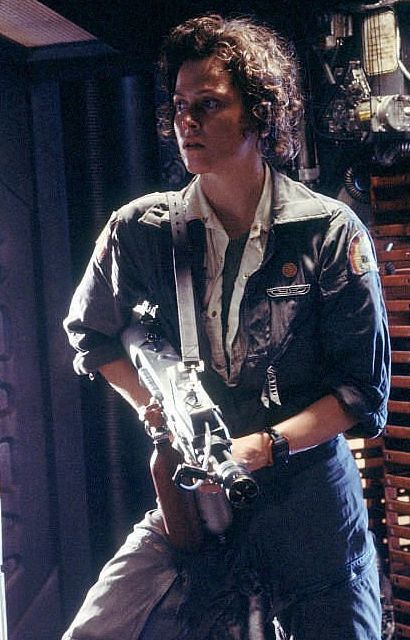★★★★½
“From bad to hearse…”
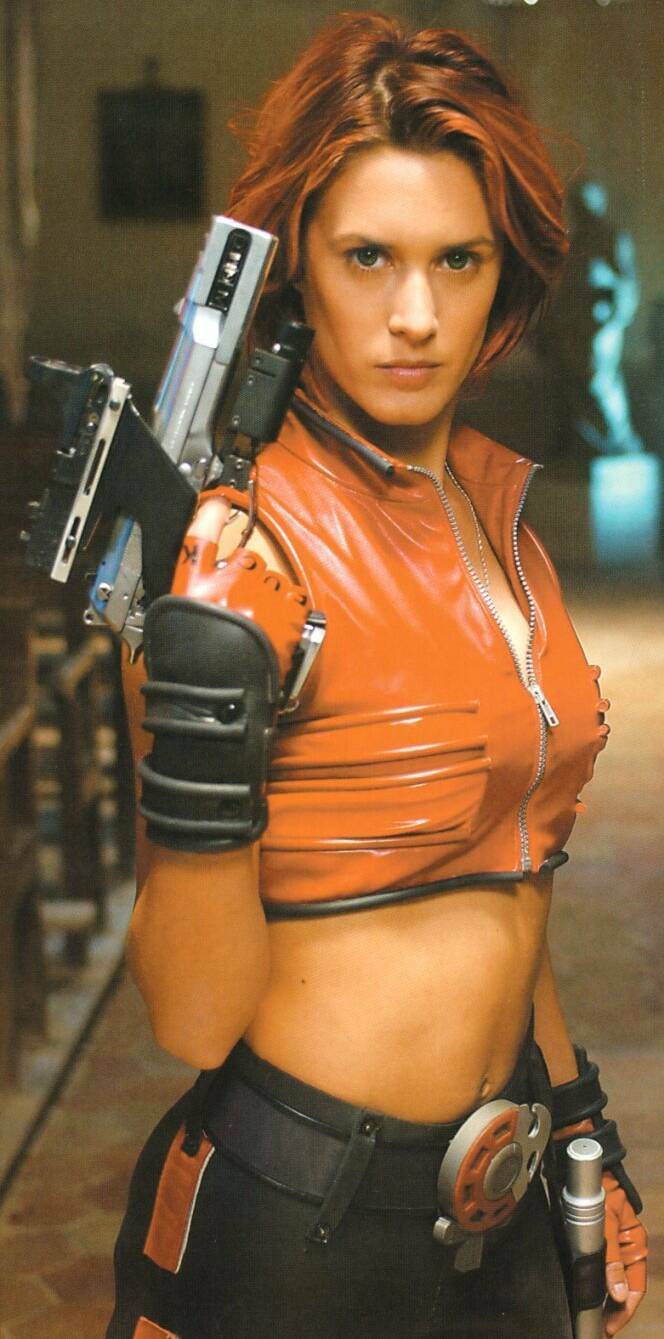
 It has been a long time since we’ve enjoyed a film so much. Right from the start, which shows a bride, in her wedding-dress, being stalked by a demon (or does it?), this grabbed our attention, and hardly let up for a second until the finale. I have to say, the odds are that you will either love this film, or fail entirely to ‘get’ what it’s trying to do and dismiss it as a lame Buffy ripoff. But in our living-room, it got four enthusiastic thumbs-up from the viewing panel, and seems like the perfect complement to beer and pizza.
It has been a long time since we’ve enjoyed a film so much. Right from the start, which shows a bride, in her wedding-dress, being stalked by a demon (or does it?), this grabbed our attention, and hardly let up for a second until the finale. I have to say, the odds are that you will either love this film, or fail entirely to ‘get’ what it’s trying to do and dismiss it as a lame Buffy ripoff. But in our living-room, it got four enthusiastic thumbs-up from the viewing panel, and seems like the perfect complement to beer and pizza.
After the opening, things for Mallory (Bonamy) go from bride to worse. [Hey, so I squeeze every drop of use from a pun. Sue me.] She’s now head of a team that investigates, and deals with, paranormal attacks – France seems to be the only country which has realised that such evil critters actually exist. She loses one member of her squad while repelling ghouls at a convent, and at the same time, new pope Hieronymus I (Spielvogel) is being kidnapped. She discovers he’s being held hostage in a nightmarish alternate dimension, so has to follow, and save the world from demonic invasion through the Hellmou…er, portal which is going to be opened, oh, any minute now.
There’s no doubt that director Julien Magnat was influenced by all the “right” films when it came to constructing his heroine: Mallory has Lola’s hair, Buffy’s martial-arts skill, the intensity of Michelle Rodriguez, and some of Resident Evil‘s Alice too. But none of them ever had gloves with ‘FUCK EVIL’ on the knuckles, drove a hearse, ran over black cats because “you never know”, or wore a tight, red waistcoat with a big ‘M’ embossed on the back [how there’s room in it for a large gun remains a charming mystery!]. Portrayed by Bonamy, who is unknown outside France (her only English-language role is a schoolgirl in Merchant-Ivory’s Jefferson in Paris), Mallory comes across as a convincing and original entry in the action heroine genre.
The other members of the team are hardly less imaginative – or, at least, the females, the guys are nowhere near so colourful or interesting. Completing the heroic trio are Vena Cava (Ribier – I think the character’s name is a Diamanda Galas reference), a six-foot “action transvestite”, as Eddie Izzard would say, an explosives expert with automatic weaponry in her platform soles, and Talking Tina, a mute telepath who can transfer her consciousness into animals or the dumber end of humanity. Both are excellent supporting characters; in a kinder universe, they would merit franchises of their own, Cava, in particular,
 Less effective or interesting are the men, and it’s abundantly clear where Magnat’s passion lies. Father Carras (Collado), the Vatican priest and papal bodyguard is bland and colourless, despite having a name borrowed from The Exorcist. The best is actually Mallory’s demon husband (Julien Boisselier), now stuck in limbo after the murderous end to their marriage. The pair have a relationship which is genuinely touching, in a way which Joss Whedon could only dream of.
Less effective or interesting are the men, and it’s abundantly clear where Magnat’s passion lies. Father Carras (Collado), the Vatican priest and papal bodyguard is bland and colourless, despite having a name borrowed from The Exorcist. The best is actually Mallory’s demon husband (Julien Boisselier), now stuck in limbo after the murderous end to their marriage. The pair have a relationship which is genuinely touching, in a way which Joss Whedon could only dream of.
On the side of evil, again, the femmes rule, with Valentina Vargas and Sophie Tellier, as Lady Valentine and her shape-shifting sidekick, Morphine, giving performances which are suitably excessive and on the money. However, the climax of the film is disappointing, largely because Mallory has no genuine nemesis, with whom she can go toe-to-toe at the end – who’s she going to beat up, the Pope? [Actually, given his intolerant statements, you’ll likely be rooting for this from the get-go]
Some of the effects definitely leave a little to be desired – the demon masks look extremely rubbery, although personally, it reminded me of another energetic B-favourite, Rabid Grannies. However, the digital effects are great, particularly the exploding bodies; we especially loved the effect of Mallory’s cross-shaped holy-water spritzer. There were many moments where we went “Cool!”, at little things like the blood-red, swirling sky in the demon realm, the evaporation of Mallory’s husband into a cloud of rose petals, or the transformations of Morphine.
The attention paid to details like these helps immeasurably, and Magnat succeds admirably in his avowed intention of making something which has the look and feel of a Japanese comic-book come to life, with a lot of Dutch angles [this week’s pretentious technical term – it means the camera’s not level]. There’s almost no natural light at all, and each character has their own colour scheme: red/black for Mallory, blue/purple for Vena, burgundy/gold for Lady Valentine. Indeed, the soundtrack is by Kenji Kawai, whose credits include Ghost in the Shell.
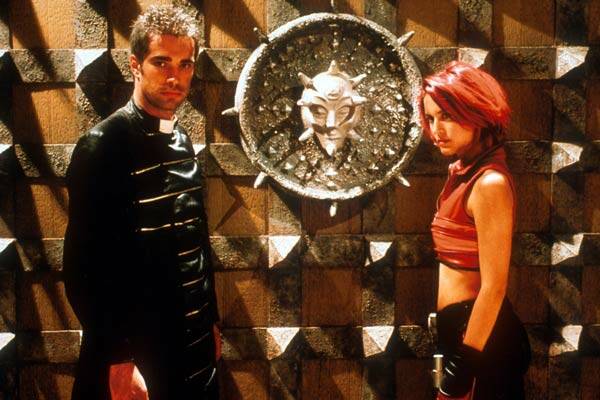 Perhaps what we enjoyed most was the balance Magnat strikes between parody and drama. This is clearly not intended to be taken seriously – but the characters keep such admirably straight faces, that it became very easy to buy into the whole mythos, which in reality wouldn’t stand up to ten seconds of close scrutiny. There’s none of the self-awareness that plagued the later seasons of Buffy, and nor is there much angst or whining. The heroine has a mission to complete, and gets on with it, in a refreshingly straightforward manner.
Perhaps what we enjoyed most was the balance Magnat strikes between parody and drama. This is clearly not intended to be taken seriously – but the characters keep such admirably straight faces, that it became very easy to buy into the whole mythos, which in reality wouldn’t stand up to ten seconds of close scrutiny. There’s none of the self-awareness that plagued the later seasons of Buffy, and nor is there much angst or whining. The heroine has a mission to complete, and gets on with it, in a refreshingly straightforward manner.
Magnat’s wants his next project to be a return to The All-New Adventures of Chastity Blade, expanding on a 32-minute short film he made in the summer of 1999. This starred Lisa (Nightmare on Elm Street) Wilcox, playing a housewife who finds herself sucked into the world of the titular 1930’s pulp-fiction heroine after getting a bullet in the head. If he brings the same sense of style and wit to that concept as we enjoyed here, it promises to be worth our attention. Meanwhile, Mallory was picked up by Lion’s Gate in November 2002, and was passed by the MPAA (R, natch) in April last year – the same week as Gigli! Since then, nothing. However, a quick search on Ebay reveals it’s available from, ahem, the usual sources. [Update: It’s due a September 2005 release on DVD] And if you see only one film about a red-headed, hearse-driving demon-hunter this, or any year, Bloody Mallory should definitely be it.
Dir: Julien Magnat
Star: Olivia Bonamy, Jeffrey Ribier, Adrià Collado, Laurent Spielvogel
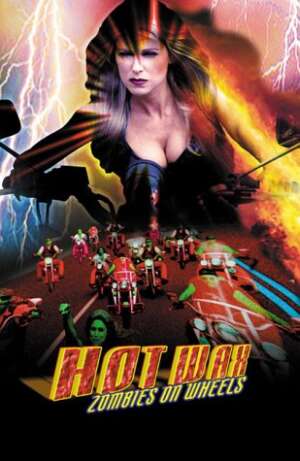 Few things are more painful than a film that wants to be cult, forgetting that such things grow organically and cannot be created at will. Witness this, which tries desperately to be hip, knowing and self-aware, but is permanently crippled by the fact that my bowel movements are more entertaining than its script. A new beauty salon opens in a sleepy town – and soon, residents are ridding themselves of “pesky body hair” thanks to its owner (Somers)…and also becoming mindless automatons. It’s up to the local exotic lingerie shop owner (Miller) to stop them, and save the world from depilation.
Few things are more painful than a film that wants to be cult, forgetting that such things grow organically and cannot be created at will. Witness this, which tries desperately to be hip, knowing and self-aware, but is permanently crippled by the fact that my bowel movements are more entertaining than its script. A new beauty salon opens in a sleepy town – and soon, residents are ridding themselves of “pesky body hair” thanks to its owner (Somers)…and also becoming mindless automatons. It’s up to the local exotic lingerie shop owner (Miller) to stop them, and save the world from depilation.




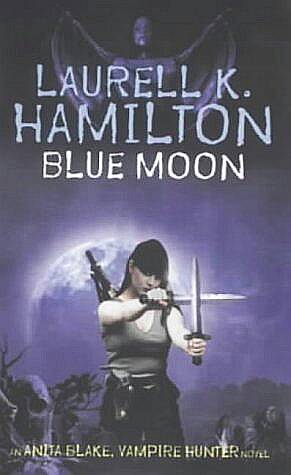 This long-running series, with the 11th entry due in 2003, takes place in an alternative reality where vampires have equal rights as citizens. Heroine Anita Blake is a state-appointed executioner (“when good bloodsuckers…go bad…“) in St. Louis, who takes out the undead trash and also has a day job – actually, more of a night job – raising zombies. Oh, did I forget to mention them? There’s also were-creatures, ghouls, and pretty much the whole range of supernatural monsters.
This long-running series, with the 11th entry due in 2003, takes place in an alternative reality where vampires have equal rights as citizens. Heroine Anita Blake is a state-appointed executioner (“when good bloodsuckers…go bad…“) in St. Louis, who takes out the undead trash and also has a day job – actually, more of a night job – raising zombies. Oh, did I forget to mention them? There’s also were-creatures, ghouls, and pretty much the whole range of supernatural monsters.
 It has been a long time since we’ve enjoyed a film so much. Right from the start, which shows a bride, in her wedding-dress, being stalked by a demon (or does it?), this grabbed our attention, and hardly let up for a second until the finale. I have to say, the odds are that you will either love this film, or fail entirely to ‘get’ what it’s trying to do and dismiss it as a lame Buffy ripoff. But in our living-room, it got four enthusiastic thumbs-up from the viewing panel, and seems like the perfect complement to beer and pizza.
It has been a long time since we’ve enjoyed a film so much. Right from the start, which shows a bride, in her wedding-dress, being stalked by a demon (or does it?), this grabbed our attention, and hardly let up for a second until the finale. I have to say, the odds are that you will either love this film, or fail entirely to ‘get’ what it’s trying to do and dismiss it as a lame Buffy ripoff. But in our living-room, it got four enthusiastic thumbs-up from the viewing panel, and seems like the perfect complement to beer and pizza. Less effective or interesting are the men, and it’s abundantly clear where Magnat’s passion lies. Father Carras (Collado), the Vatican priest and papal bodyguard is bland and colourless, despite having a name borrowed from The Exorcist. The best is actually Mallory’s demon husband (Julien Boisselier), now stuck in limbo after the murderous end to their marriage. The pair have a relationship which is genuinely touching, in a way which Joss Whedon could only dream of.
Less effective or interesting are the men, and it’s abundantly clear where Magnat’s passion lies. Father Carras (Collado), the Vatican priest and papal bodyguard is bland and colourless, despite having a name borrowed from The Exorcist. The best is actually Mallory’s demon husband (Julien Boisselier), now stuck in limbo after the murderous end to their marriage. The pair have a relationship which is genuinely touching, in a way which Joss Whedon could only dream of. Perhaps what we enjoyed most was the balance Magnat strikes between parody and drama. This is clearly not intended to be taken
Perhaps what we enjoyed most was the balance Magnat strikes between parody and drama. This is clearly not intended to be taken 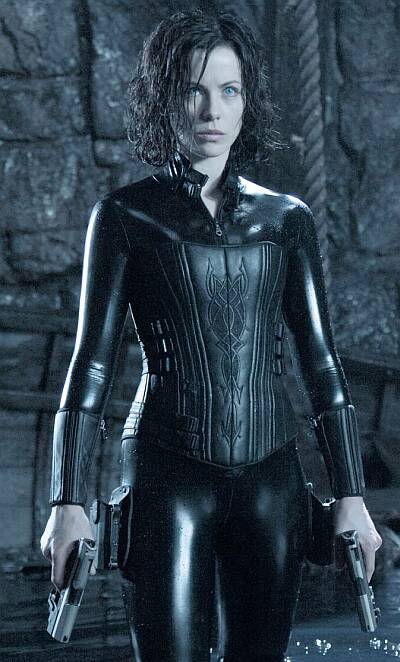 While undeniably flawed, the original Underworld had a big ace up its sleeve, in the basic concept of “vampires vs. werewolves”, which hadn’t received such a full-on depiction in cinema before. This time, the idea is familiar, and the story doesn’t have anything quite as cool to replace it. Sure, there’s the old fall-back of Kate Beckinsale in a PVC suit, but the sense of something genuinely new is rarely apparent. Sure, it’s a sequel, which in Hollywood translates to “more of the same”, but the lack of invention on view is still disappointing.
While undeniably flawed, the original Underworld had a big ace up its sleeve, in the basic concept of “vampires vs. werewolves”, which hadn’t received such a full-on depiction in cinema before. This time, the idea is familiar, and the story doesn’t have anything quite as cool to replace it. Sure, there’s the old fall-back of Kate Beckinsale in a PVC suit, but the sense of something genuinely new is rarely apparent. Sure, it’s a sequel, which in Hollywood translates to “more of the same”, but the lack of invention on view is still disappointing.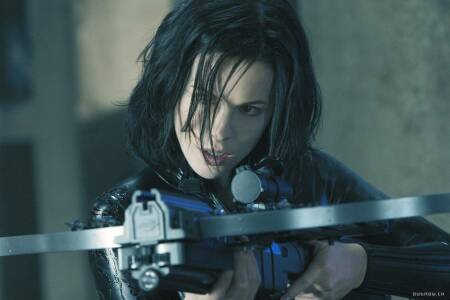 No, it’s the moments between the battles that are the problems, not least a dumb and gratuitous sex scene between Selene and Michael that appears to have wandered in from an airline version of a SkineMax movie. And the exposition also has to count as among the most leaden of recent times, achieving the rare double-bill of sending Chris and I independently off to sleep. Hey, we’d been out boating all day. So sue us. :-) However, for any action-fantasy to have both of us snoozing is definitely problematic.
No, it’s the moments between the battles that are the problems, not least a dumb and gratuitous sex scene between Selene and Michael that appears to have wandered in from an airline version of a SkineMax movie. And the exposition also has to count as among the most leaden of recent times, achieving the rare double-bill of sending Chris and I independently off to sleep. Hey, we’d been out boating all day. So sue us. :-) However, for any action-fantasy to have both of us snoozing is definitely problematic.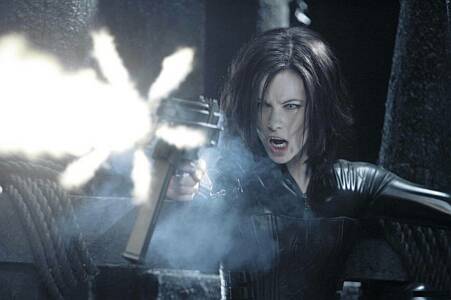
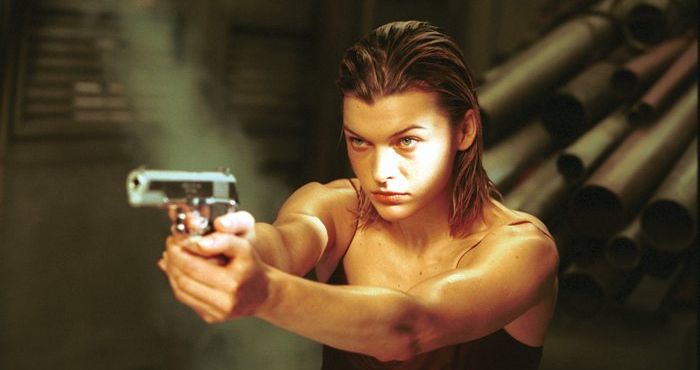
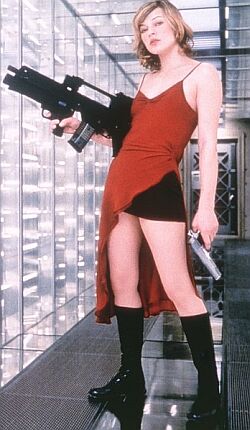 Interestingly, in the past year, all three of the computer-game to movie adaptations have had heroines: Lara Croft, Aki (Final Fantasy), and now, Resident Evil‘s Alice, who wakes up one day with a splitting headache and no memory. I’ve had mornings like that too. However, I never found myself kidnapped by a SWAT team and dragged into the Hive, an underground complex populated by the walking dead (human
Interestingly, in the past year, all three of the computer-game to movie adaptations have had heroines: Lara Croft, Aki (Final Fantasy), and now, Resident Evil‘s Alice, who wakes up one day with a splitting headache and no memory. I’ve had mornings like that too. However, I never found myself kidnapped by a SWAT team and dragged into the Hive, an underground complex populated by the walking dead (human 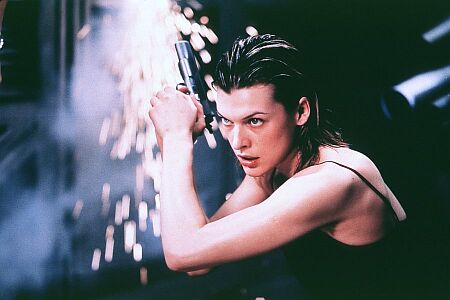 This is to…er, well, I think it was to disarm the computer, but I’m not certain about that. Mind you, I’m not certain about quite a lot in this movie. The characterisation is so woeful, I managed to combine two opposing characters into one for the entire film. And it still made sense – indeed, even after Chris enlightened me, I felt my version was better. My version would also have discarded the clock countdown, or used it as the basis for an exciting race against time through the tunnels. What’s the point of a countdown, if you don’t see it in the last ten minutes? There’s also maddeningly shallow nods to Lewis Carroll: the heroine is called Alice, who goes down a “rabbit hole”, while the computer is the Red Queen with a fondness for lopping off peoples’ heads. You should either do this stuff to the hilt, or not at all.
This is to…er, well, I think it was to disarm the computer, but I’m not certain about that. Mind you, I’m not certain about quite a lot in this movie. The characterisation is so woeful, I managed to combine two opposing characters into one for the entire film. And it still made sense – indeed, even after Chris enlightened me, I felt my version was better. My version would also have discarded the clock countdown, or used it as the basis for an exciting race against time through the tunnels. What’s the point of a countdown, if you don’t see it in the last ten minutes? There’s also maddeningly shallow nods to Lewis Carroll: the heroine is called Alice, who goes down a “rabbit hole”, while the computer is the Red Queen with a fondness for lopping off peoples’ heads. You should either do this stuff to the hilt, or not at all. ★★★½
★★★½ The day before this opened, we watched a “documentary” on AMC, entitled Fang vs. Fiction: The Real Underworld of Vampires and Werewolves. Quotes used advisedly, as they must be when the program interviewed someone who said he was a werewolf. Regrettably, despite our yelling at the TV, he refused to transform on camera, claiming it was too taxing. Wuss. What it did demonstrate was that the old stereotypes are alive and well – or at least
The day before this opened, we watched a “documentary” on AMC, entitled Fang vs. Fiction: The Real Underworld of Vampires and Werewolves. Quotes used advisedly, as they must be when the program interviewed someone who said he was a werewolf. Regrettably, despite our yelling at the TV, he refused to transform on camera, claiming it was too taxing. Wuss. What it did demonstrate was that the old stereotypes are alive and well – or at least  What doesn’t work, on any level, is the Selene-Corvin relationship, which is never given any reason to blossom as it does. Worse, still, though the film is told largely from Selene’s point of view, at the end, it’s Corvin who has to battle against The Big Bad [and I’d best not say who that is; the film takes delight in pulling the carpet out from under the viewer]. Sure, Selene gets to deliver the coup de grace – and impressively so – but reducing the heroine to someone left holding her man’s coat, is mostly why this one doesn’t get our seal of approal. Making it even more embarrassing, by this stage, the hero looks like a blue version of the Incredible Hulk.
What doesn’t work, on any level, is the Selene-Corvin relationship, which is never given any reason to blossom as it does. Worse, still, though the film is told largely from Selene’s point of view, at the end, it’s Corvin who has to battle against The Big Bad [and I’d best not say who that is; the film takes delight in pulling the carpet out from under the viewer]. Sure, Selene gets to deliver the coup de grace – and impressively so – but reducing the heroine to someone left holding her man’s coat, is mostly why this one doesn’t get our seal of approal. Making it even more embarrassing, by this stage, the hero looks like a blue version of the Incredible Hulk.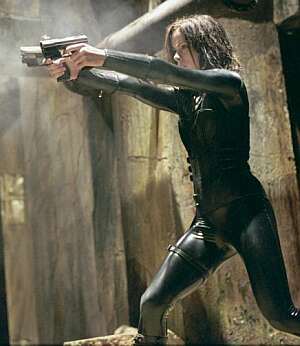 There are some plot points which are never quite explained. At one point, Selene hides Corvin in a safe house, which then mysteriously comes under attack from the lycanthropes. How did they know? Why the werewolves don’t take advantage of the daylight, and avoid moving around at night when the vampires are about? It probably also gets rather too embroiled in creating an entire society and culture for the vampires, explaining stuff not necessary to a 90-minute movie – that’s why it’s actually a 121-minute movie.
There are some plot points which are never quite explained. At one point, Selene hides Corvin in a safe house, which then mysteriously comes under attack from the lycanthropes. How did they know? Why the werewolves don’t take advantage of the daylight, and avoid moving around at night when the vampires are about? It probably also gets rather too embroiled in creating an entire society and culture for the vampires, explaining stuff not necessary to a 90-minute movie – that’s why it’s actually a 121-minute movie.